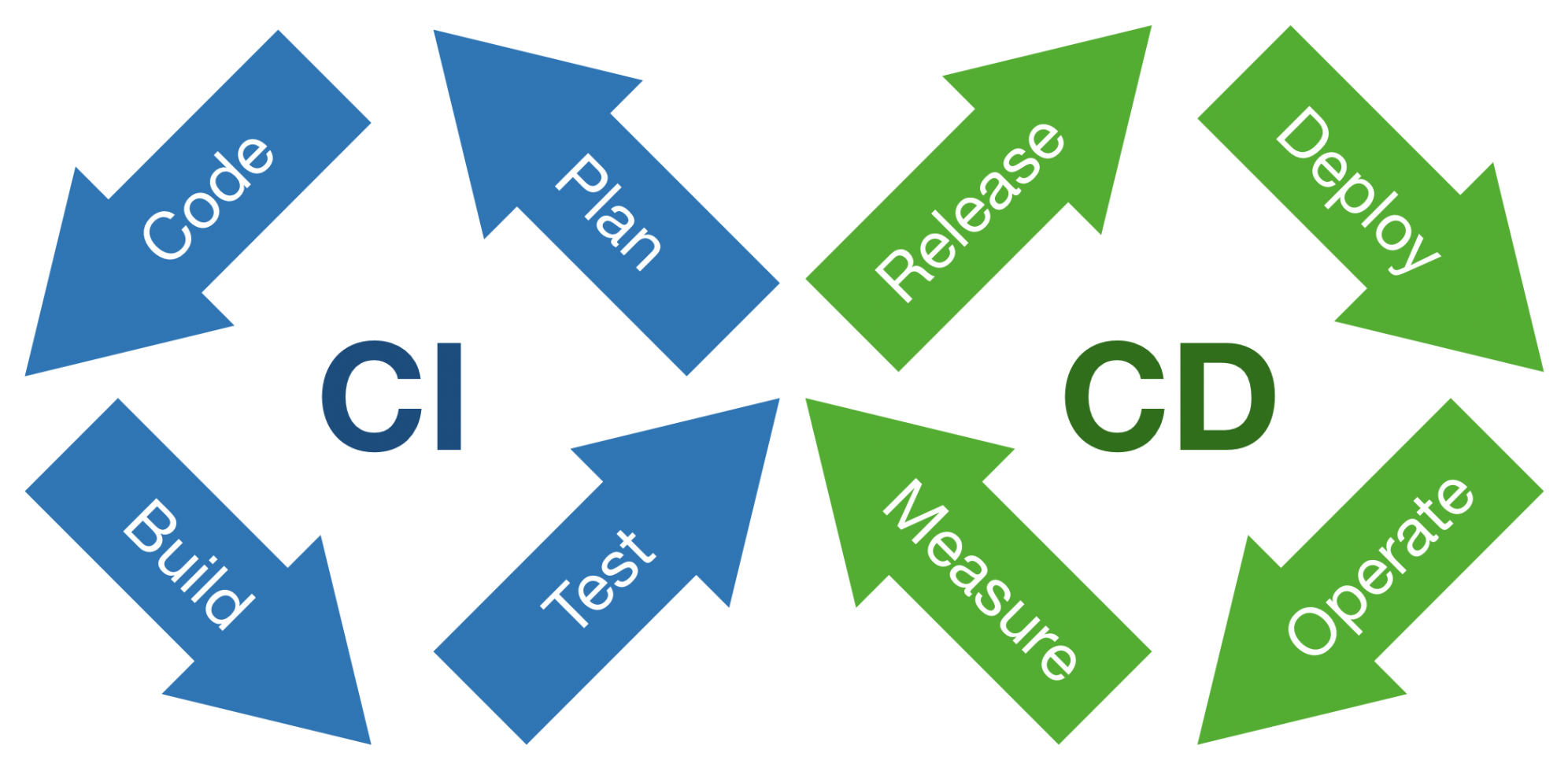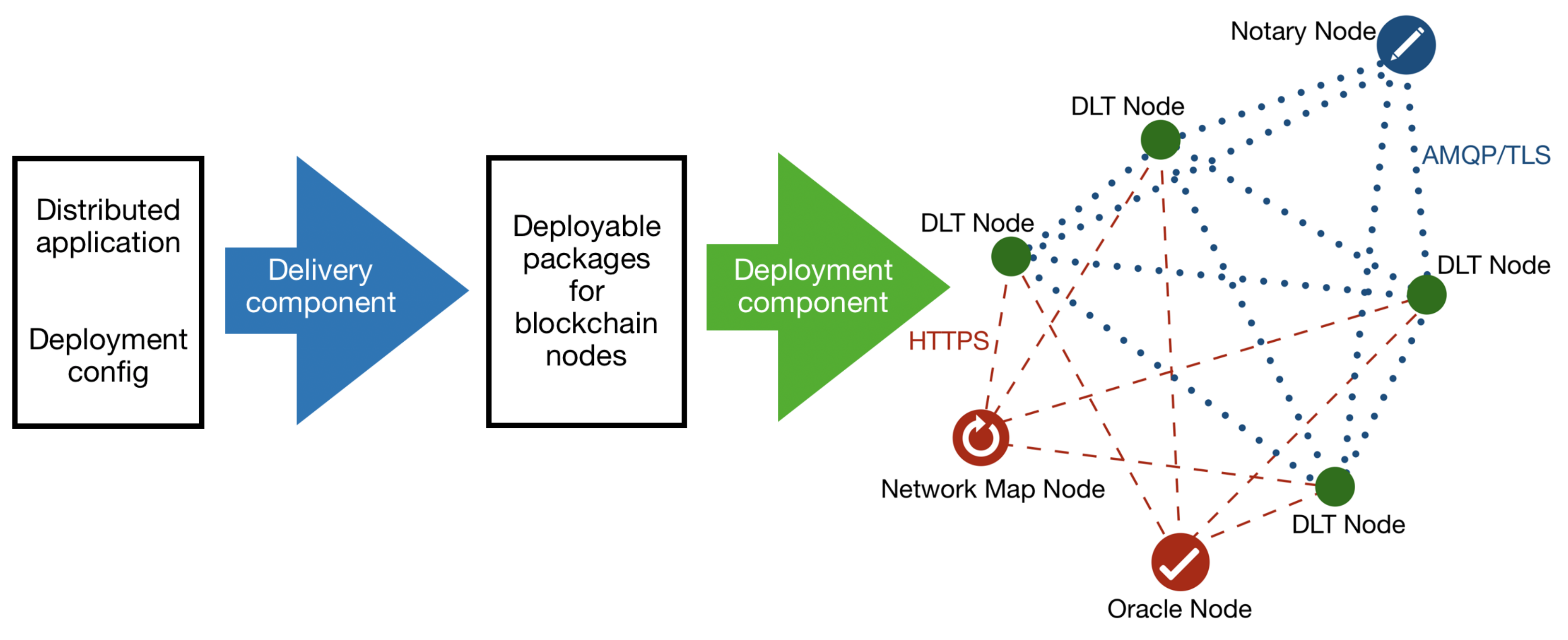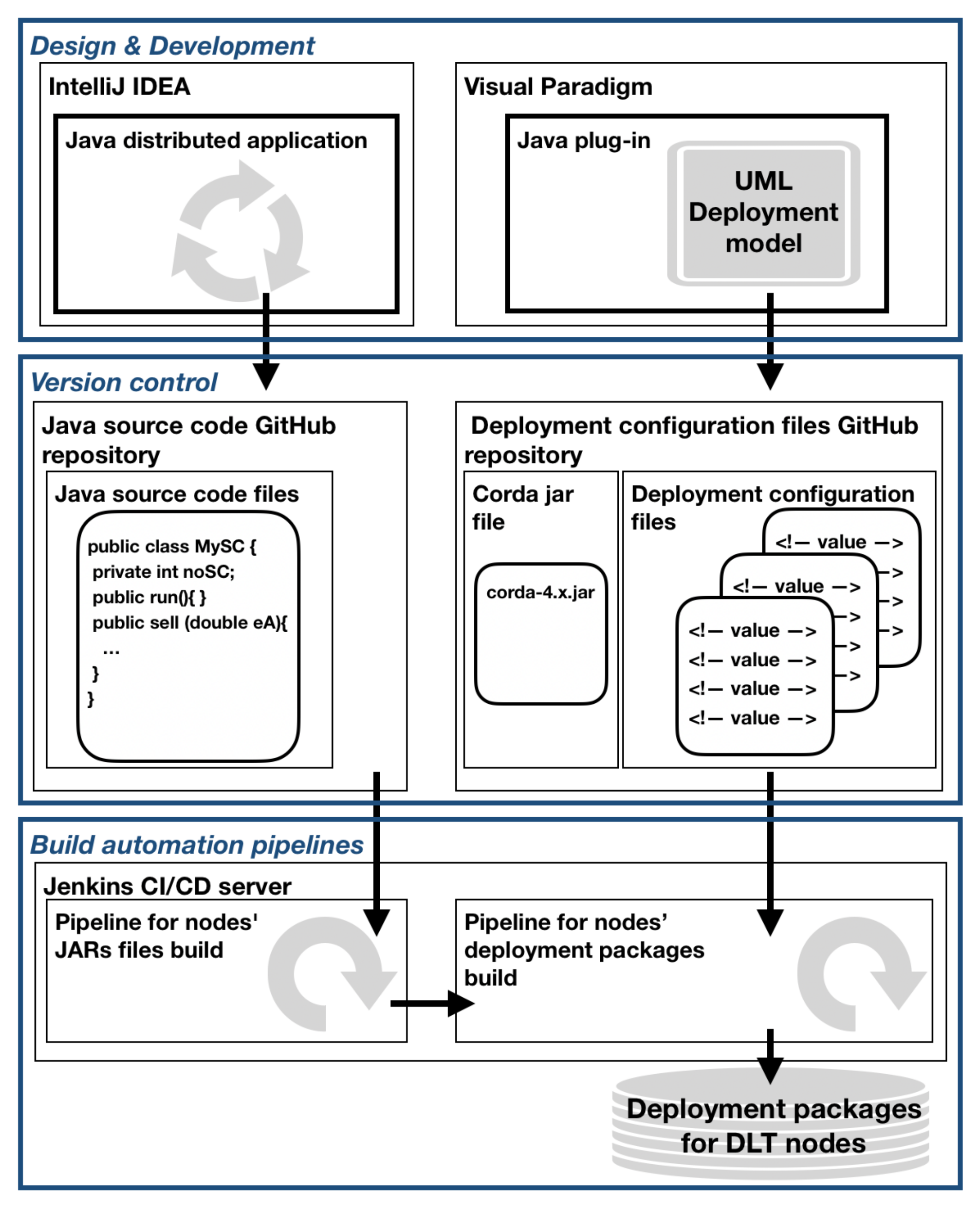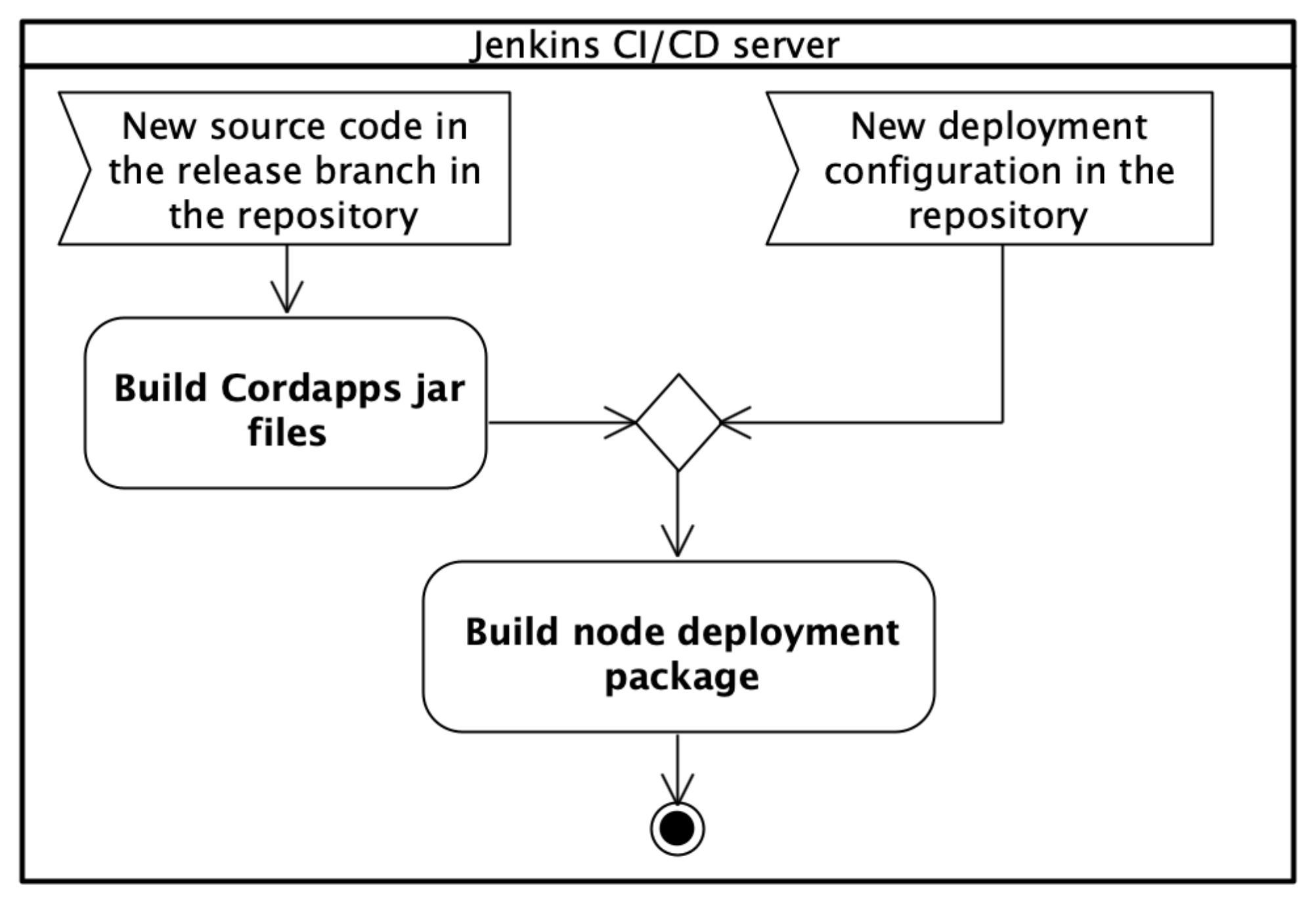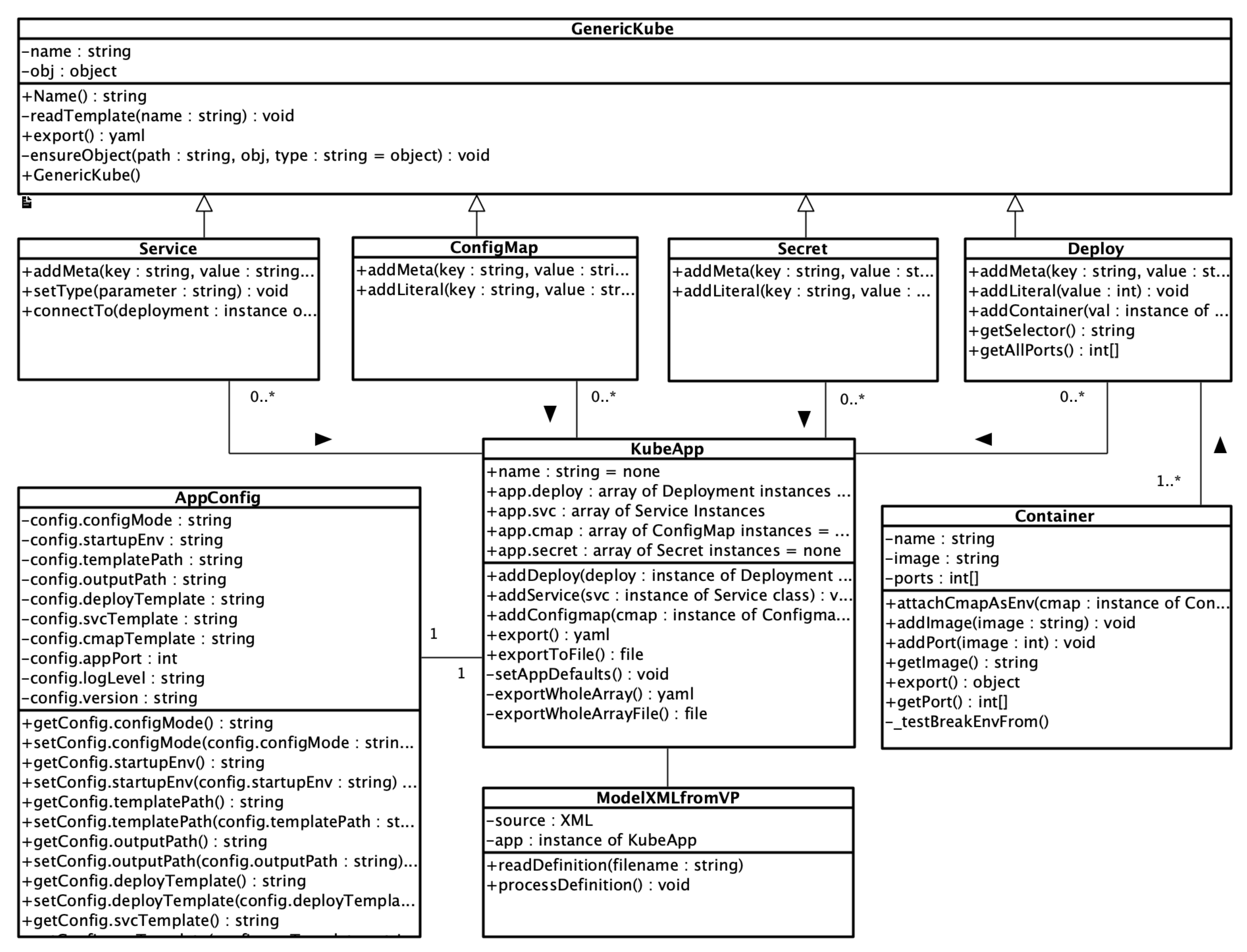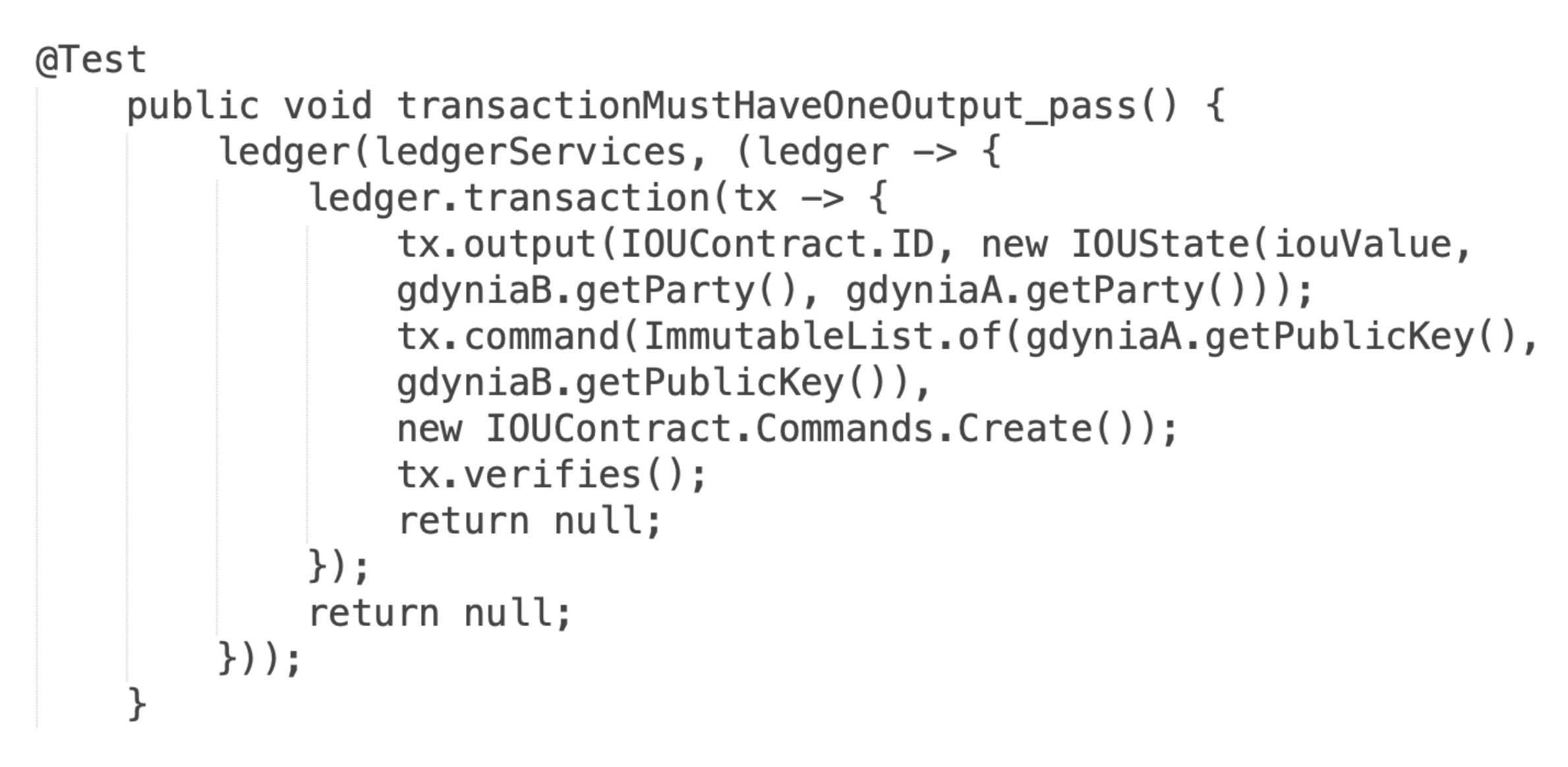1. Introduction
The primary principle of the Agile Manifesto underlines the importance of early and continuous delivery of software that meets the customer needs [
1]. Abbreviations have been provided for the following notions: Continuous integration (CI), continuous delivery (CD), and continuous deployment (CDT). The first practice involves that software is integrated continuously during development. The practice encompasses automation of software builds and testing. The backbone of a CI is version control. The most popular GitHub service ensures the distributed version control of source code using Git. The new or changed code is incorporated into a build and checked by automated tests. Automation of testing ensures checking that the application works correctly in case new commit is merged with the release branch. The CD approach goes even further in software development automation. It aims to enable on-demand software release. CD employs a set of stages, including the acceptance tests and release process. Automated acceptance tests and the release process allow on deployment of application under development on demand. Humble and Farley [
2] present a comprehensive description of the continuous delivery process. They have defined the notion of the deployment pipeline as an automated process of tasks, which is responsible for producing a release. CD practice requires specific governance to act properly, i.e., infrastructure, data, and configuration management. The CDT approach elevates automation on an even higher level. It automatically deploys every release to users’ acceptance tests environments or even a production one. CDT is a push-based practice. Conversely, CD approach is a pull-based one.
Figure 1 presents loop of steps in continuous integration and continuous delivery approaches. The loop makes a complete CDT approach.
The author has observed increasing interest in continuous approaches. Shahin et al. [
3] have found the following important topics: Reducing build and test time, automation of tests, raising the scalability of deployment pipelines, and elevating the deployment process reliability. They have also enumerated essential elements in implementing continuous approaches. They have underlined suitable infrastructure, testing, highly skilled programmers, and a proven design process. Debroy and Miller [
4] show actions to overcome challenges in implementing continuous practices. They use custom images for building agents to handle micro-service dependencies. They also apply orchestration to manage resources in order to keep infrastructure costs low. Keeping build and release times short requires employing an orchestrator, such as Kubernetes (K8s), to handle scaling. Recently, IEEE Standard for DevOps has been approved and published [
5]. The standard provides requirements and guidance on the implementation of DevOps to define, control, and improve software life cycle processes. It applies within an organization or a project for building and deploying software reliably. The efficiency of the continuous integration process has been improved by Abdalkareem et al. [
6] through identifying commits that can be skipped. The proposed prototype tool works with
Git repositories. Continuous integration and delivery tools have been analyzed by Prado Lima et al. [
7] in the view of test case prioritization. They have analyzed the following environments: BuildBot, GoCD, Integrity, Jenkins, and Travis CI. For this work, GoCD and Jenkins were considered. Both are open-source, written in Java, and integrate well with both K8s and GitHub. However, Jenkins offers better support for continuous integration. These environments do not provide ready-made functions for blockchain. However, they offer an application programming interface (API) and thus the possibility of extending their functionality. A newly published paper by Leite et al. [
8] touches on continuous delivery practice. They have analyzed the structure of DevOps teams and communication between them. So, the subject seems to be timely.
The underlying technology for blockchain is distributed ledger. Xu et al. [
9] provide the following definition of a distributed ledger: “A distributed ledger is an append-only store of transactions which is distributed across many machines.” A consensus algorithm is a fundamental component of a distributed ledger and blockchain that ensures synchronization among multiple peers. There are two main well-established consensus algorithms: Proof-of-work (PoW), and proof-of-stake (PoS). The author would like to draw attention to the fact that there are works on alternative approaches [
10,
11]. Blockchain is a disruptive technology. Casino et al. [
12] have done a thorough literature review of blockchain-based applications. They enumerate many uses, but emphasize the vast opportunities in the energy sector. Researchers and practitioners use various blockchain frameworks. An extensive comparison of permissioned (private) and permissionless (public) blockchain frameworks have been done by Chowdhury et al. [
13]. They have chosen, e.g., Hyperledger Fabric, Ethereum, IOTA, Multichain, and R3 Corda. The latter is a private ledger where consensus involves two DLT nodes that participate in the transaction, which is signed by the Notary node. It has a vast impact on scalability. In the ledger, there is also a Network Map node and Oracle nodes. In a transaction, two DLT nodes and one Notary node take part. The R3 Corda’s block creation time is 0.5–2.0 [s], which places the framework among the fastest. Moreover, the usage of energy by the framework is almost negligible. A DLT node hosts distributed applications (CorDapps) and services. The main services are oracle, notary, network map, and permissioning. A Corda network is a fully connected graph. The communication among DLT nodes and the Notary node is done via an Advanced Message Queuing Protocol over Transport Layer Security (AMQP/TLS). Moreover, it uses a Hypertext Transfer Protocol Secure (HTTPS) for the communication of DLT nodes with the Network Map and Oracle nodes. In the case of energy systems, permissioned blockchain networks fit best. They fulfill privacy requirements and can facilitate peer-to-peer energy exchange. The approach uses the R3 Corda blockchain-based Electricity Consumption and Supply Management System (ECSM) that enables energy exchange between prosumers.
The contribution is the continuous deployment approach for generating complete node deployment packages for blockchain nodes and running the blockchain network in a containerized environment.
Figure 2 shows a scheme of the solution.
Blockchain introduces an additional level of difficulty for continuous practices. In addition to ensuring the proper functioning of the business application, there are a variety of deployment configurations for blockchain nodes. Ozkaya et al. [
14] have found that the functional and information views are the most popular ones in software architecture modeling. Zou et al. [
15] have conducted an analysis to discover the actual obstacles that developers have to overcome while developing smart contracts. Results revealed that the source code of smart contracts is compromised as far as security is concerned. Besides, they claim that the development support of blockchain applications in existing tools is still incomplete. The approach offers design support for the
Deployment view and uses the Unified Modeling Language (UML) Profile for Distributed Ledger Deployment. The key element in a blockchain is a smart contract. The approach offers a unique
Contracts view to describe smart contracts within the 1 + 5 architectural views model. Górski in [
16] has shown the
Smart Contract Design Pattern that offers a flexible manner for designing smart contracts in a permissioned distributed ledger. The pattern has been incorporated into the delivery component. That component uses the Visual Paradigm modeling tool and automates build release tasks with the Jenkins server. The continuous deployment component, still under design, uses the Kubernetes platform for automating the deployment of blockchain distributed applications in containers.
The following part of the communication is arranged as follows.
Section 2 outlines the design of the delivery component.
Section 3 discusses the preliminary design of the deployment component.
Section 4 introduces the method of validation of the delivery component that allows for checking the consistency between generated deployment scripts and UML models. The section also presents the validation method of the business application.
Section 5 concludes the work done and shows already planned tasks.
2. The Design of the Delivery Component
Various architectural principles have been applied to the design of the continuous delivery component. Firstly, there have been imposed
Modularity and
Separation of responsibility principles on the approach design. The following layers have been identified: Design & Development, Version control, and Build automation pipelines. The
Design & Development layer consists of the
UML Deployment model of the distributed ledger solution and the model-to-code transformation. The model uses the
UML Profile for Distributed Ledger Deployment profile. The second module is the
Java distributed application, which realizes a smart contract. The first module is designed in Visual Paradigm whereas the second one is developed in IntelliJ IDEA. Both tools have a community edition. The IntelliJ IDEA works smoothly with GitHub repositories. Java has been chosen for portability reasons but has two uses. It has been used to implement a distributed blockchain application. Moreover, it is the language of developing the transformation application and plug-in for Visual Paradigm. The
Version control layer comprises Git repositories. The first one encompasses the source code of the smart contract application and Corda execution environment. The second repository consists of deployment configuration files for DLT nodes. The
Build automation pipelines layer encompasses both Jenkins pipelines. The first one automates the generation of the smart contract application and Corda runtime JAR files. The second pipeline automates the generation of the complete ZIP file that consists of the application, Corda runtime, and deployment configuration files for nodes. Deployment packages for nodes are stored by the open source Jenkins automation server. The delivery component is still under construction.
Figure 3 depicts the overview of the delivery component for generating blockchain deployment packages.
2.1. UML Profile for DLT Deployment
The approach concentrates on the Platform Specific Model (PSM) to express the precise deployment configuration of the R3 Corda framework in version 4.6. Stereotypes and tagged values have been used for defining the profile with the needed semantic enrichment for
Deployment view modeling. Stereotypes have been applied to represent nodes, services, and communication protocols. Tagged values have been used to define deployment configuration parameters for nodes. First, tagged values have been identified that describe parameters common for all types of nodes and placed in the ≪CordaNode≫ stereotype. Then, there have also been defined tagged values for the notary node and placed in the ≪NotaryNode≫ stereotype. In the current version of the profile, the deployment parameters of the notary node operating in the high availability mode has been taken into account [
16,
17]. All stereotypes for Corda network nodes have a common set of tagged values because they inherit from the ≪CordaNode≫ stereotype.
2.2. The Model-to-Code Transformation
The delivery component incorporates model-to-code transformation for generating blockchain deployment scripts [
18]. The source of the transformation is a UML Deployment model. The current version of the UML profile has been used. The second vital change in the design of the transformation is the ability to store generated deployment scripts at GitHub under Git version control. The transformation ensures consistency of the
UML Deployment model with deployment configuration files of blockchain nodes.
2.3. Delivery Pipelines
The open-source Jenkins automation server has been used. The main notion in the Jenkins automation server is a pipeline. A pipeline can be described as an automated process of generating a releasable package on the basis of software stored under version control. A pipeline defines your entire build process, which typically includes stages. A stage block defines a conceptually distinct subset of tasks. A single task tells Jenkins what to do at a particular step in the process. Correct node deployment package involves both business logic and deployment configuration details. Thus two Jenkins pipelines have been introduced. The Build node deployment package pipeline is responsible for completing the full node deployment package using CorAapps jar files and deployment configuration scripts. The Build Cordapps jar files pipeline is responsible for building an up-to-date version of CorDapps JAR files and is triggered when a new source code of business logic appears in the repository. After finishing execution, the pipeline triggers the Build node deployment package pipeline. Such division allows for the separation of the Java source code of business logic from the node deployment configuration. The pipeline Build node deployment package is triggered when a new deployment configuration is generated from the UML Deployment model.
Figure 4 depicts the UML activity diagram with designed pipelines.
Both elements, the redesigned model-to-code transformation and delivery pipelines are still under construction.
Figure 5 shows results of the single execution of the
Build Cordapps jar files pipeline. The Jenkins automation server collects values of the following metrics:
Average stage time and
average full run time. The pipeline execution time for the blockchain network of 5 business nodes is under 50 [s]. It looks promising in view of processing larger networks.
The Jenkins server with implemented pipelines has been exposed in the domain of the statutory project: model.amw.gdynia.pl.
4. Validation
Validation determines whether a system or component satisfies requirements specified by the user. Validation of such a solution includes two stages: Delivery and deployment. At both stages, the tests must concern the business application and deployment configurations of the blockchain network nodes. At the delivery stage, unit tests are designed for individual methods in the business application and integration tests verify the operation of the business application in blockchain nodes running on the test environment. The same set of tests must be passed by the business application at containerized environments e.g., user acceptance tests and staging.
As far as deployment configurations are concerned, the consistency of deployment scripts with the UML Deployment model should be verified. A single deployment configuration file and the corresponding UML node are considered. The UML node comprises tagged values,
. The script contains deployment configuration parameters,
. Intersection of two sets
D and
T is denoted by
, and is the set containing all elements of
D that also belong to
T or similarly, all elements of
T that also belong to
D. It means checking that the intersection meets the following Equation (
1):
The cardinality of both sets should be the same. The deployment configuration parameter
d is an ordered pair,
, where:
is the name, and
is the value of
d. The tagged value
t is an ordered pair,
, where:
is the name, and
is the value of
t. For each
, there must be
with the same name and value (
2).
Similarly, for each
, there must be
with the same name and value (
3).
Apart from verifying deployment configuration files, there are designed tests for the business application. A dedicated test class has been designed for testing verification rules in the smart contract.
Figure 7 depicts the test case for one of the smart contract verification rules. The preliminary tests have been conducted for the ECSM system [
19].
Tests have confirmed that the delivery component works correctly.
